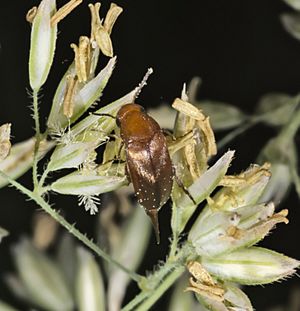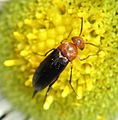Mordellistena facts for kids
Quick facts for kids Mordellistena |
|
|---|---|
 |
|
| Mordellistena neuwaldeggiana | |
| Scientific classification | |
| Kingdom: | |
| Phylum: | |
| Class: | |
| Order: | |
| Suborder: | |
| Family: |
Mordellidae
|
| Genus: |
Mordellistena
Costa, 1854
|
Mordellistena is a large group, or genus, of small beetles. These beetles belong to the family called Mordellidae. There are many different species of Mordellistena beetles found all over the world.
These interesting insects are often called "tumbling flower beetles." They get this name because of the way they move. When they feel threatened or need to escape from animals that might want to eat them, they make quick, jerky, and irregular movements. It looks like they are tumbling or flipping around, which helps them confuse predators and get away quickly.
Contents
What Are Tumbling Flower Beetles?
Tumbling flower beetles are usually small, often less than 1 centimeter long. They have a unique body shape that helps them move so quickly. Their bodies are often wedge-shaped, meaning they are wider at the front and narrower at the back. This shape, along with their strong legs, allows them to perform their famous tumbling escapes.
Where Do They Live?
You can find Mordellistena beetles in many different places around the world. They prefer areas where there are lots of flowers, as they often live on or near plants. They are common in gardens, meadows, and forests.
What Do They Eat?
Most Mordellistena beetles are known to feed on pollen and nectar from flowers. This makes them important pollinators, helping plants reproduce. They spend a lot of their time on flowers, which is also why they are called "flower beetles."
Life Cycle of Mordellistena
Like all beetles, Mordellistena goes through a complete metamorphosis. This means they have four main stages in their life: egg, larva, pupa, and adult.
The Larva Stage
The young beetles, called larvae, look very different from the adult beetles. Mordellistena larvae typically live inside plant stems or decaying wood. They feed on the plant material, helping to break it down. This stage is all about growing and storing energy.
From Pupa to Adult
After growing enough, the larva changes into a pupa. This is a resting stage where the beetle transforms from its larval form into an adult. Once the transformation is complete, the adult beetle emerges, ready to find food and reproduce.
Images for kids
See also
 In Spanish: Mordellistena para niños
In Spanish: Mordellistena para niños




